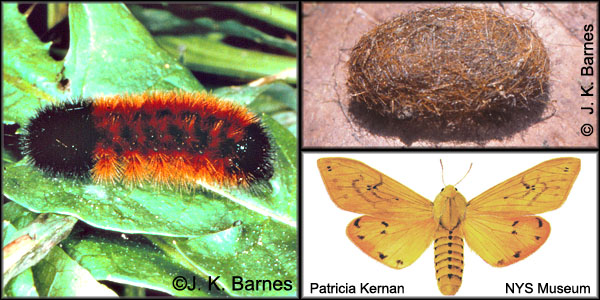Woolly bear caterpillar
Order: Lepidoptera
Family: Arctiidae
Genus and species: Pyrrharctia isabella (Smith)
In earlier times, when most Americans were involved in agricultural pursuits, the nation’s welfare was defined by the weather, and severe winters had severe consequences. Folks living close to nature observed how plants and animals seemed to prepare for winter. Weather folklore is rich with insect and spider motifs. Large numbers of spiders or crickets in the house foretell of cold winters. Bees prepare and unusually large store of honey before a severe winter. Flies seeking shelter in early autumn are harbingers of frosty mornings and cold storms.
But our most famous six-legged prophets are woolly bear caterpillars, which are said to predict the severity of the coming winter by the relative widths of their black and brown bands.
The woolly bear caterpillar is the larva of the Isabella tiger moth. Each of its three thoracic and ten abdominal segments is ringed by tufts of long, stiff, barbed spines or setae that arise from closely spaced tubercles on the black integument. These setae no doubt offer enemies an uncomfortable mouthful. Early farmers observed that chickens would scrutinize the caterpillars, but would not devour them. In mature caterpillars, the segments of the front- and rear-end bear black setae, and typically four to six middle segments have reddish-brown setae. Therefore, the caterpillars appear to have black bands at both ends and a rest colored band in the middle. However, banding patterns are so variable that some caterpillars might seem to be different species. Some can ever appear entirely black or entirely rust colored.
Folklore, which originated in Europe, tells us that the amount of black on the woolly bear in autumn varies proportionately with the severity of the coming winter in the locality where the caterpillar is found. The longer the woolly bear’s black bands, the longer, colder, snowier, and more severe the winter will be. Similarly, the wider the middle brown band, the milder the coming winter. The position of the longest dark bands supposedly indicates which part of winter will be coldest or hardest. If the head end of the caterpillar is dark, the beginning of winter will be severe. If the tail end is dark, the end of winter will be cold.

Mary Celestia Parler (1905-1981) spent roughly three decades teaching folklore classes at the University of Arkansas. She organized the University Folklore Research Project (1949-1965), and with her future husband, Vance Randolph, and several others established the Arkansas Folklore Society. She gathered volumes of folklore from her students. To date, this material is largely unpublished, but it is cataloged and available for use by researchers at the University of Arkansas Library in Fayetteville. One contributor from Bentonville proclaimed, “During the summer if the wallyworms are black, it is going to be a tough winter.” Another contended, “If more black than yellow caterpillars are in circulation the the fall of the year, the winter will be severely cold.” And another, from El Dorado, stated, “The wider the reddish brown streak on the wooly bear caterpillar in the fall, the milder the winter will be.”
Woolly bears were described by the New York Herald Tribune in 1955 as “those fuzzy caterpillars whose renowned weather predictions are taken with a pound of salt by scientists, but accepted with hope and charity by thousands of Americans.” Entomologists realize that the segments of young caterpillars have mostly black setae, and with each molt, individuals gain more rust colored rings. Some insect specialists have claimed that woolly bears develop uniform black coloration under wet conditions. Scientists believe that variations in caterpillar color patterns are caused by factors other than the severity of the coming winter.
In autumn, the caterpillars settle into secluded sites under fallen logs or among rocks. They overcome a lack of food and freezing temperatures with low metabolic rate and accumulation of antifreeze chemicals. Caterpillars frozen in solid ice when thawed have been known to move around as if nothing had happened.
In April or May, after a brief period of activity, woolly bears find a tangle of wood, bark, or rocks, and enclose themselves in dark-colored oval cocoons consisting of silken threads interwoven with black and red setae. They then change into pupae, and the fully formed and flying adults are ready to mate by June or July. The second generation of adults is produced later in summer. Adult Isabella tiger moths have a wingspan of about 1½ to 2 inches. The wings and abdomen are dull yellow with black or gray spots. These very common moths fly at night from June to September. During the feeding period, caterpillars tend to confine themselves near the ground to lower leaves, thereby remaining inconspicuous and causing little injury to their food plants, which include plantain, campion, aster, dandelion, clover, and various grasses. They seldom attack crops or ornamental plants.
Fully grown caterpillars are about 1½ inches long, and they are among the woolliest of caterpillars. When disturbed they sometimes feign death by doubling up, with the thick masses of spine-like hairs projecting outward to protect the vulnerable underside, much like a hedgehog.
The Isabella tiger moth and banded woolly bear caterpillar occur throughout North America, except for northern Canada and Alaska. They occur across Arkansas. They are found in gardens, meadows, pastures, uncultivated fields and along road edges.
